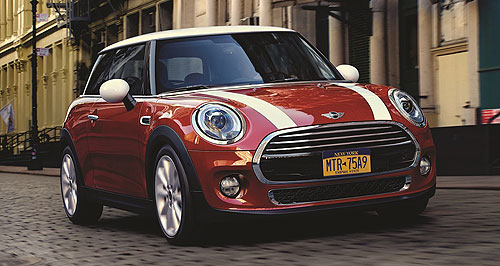Make / Model Search
News - MiniFrankfurt show: Mini moves beyond retroNew for old: A new chief designer at Mini could change up the familiar look of Mini models. Mini branding and design shifts as global sales keep rising15 Sep 2017 By TIM NICHOLSON in FRANKFURT MINI senior vice-president Sebastian Mackensen says the BMW Group-owned British brand is no longer seen as a niche retro brand as it looks to smash another global sales record this year. The iconic 1960s brand was reborn under the German auto giant in 2001 with a three-door hatch that was a modern take on the original and followed the launch of Volkswagen’s New Beetle as part of a wave of nostalgic retro cars. Mr Mackensen told Australian journalists at the Frankfurt motor show this week that he believed the brand had moved beyond simply being a quirky retro offering, thanks in part to the addition of new model lines. “I would like to think yes, but somehow still having a little bit of that (retro feel),” he said. “The round lights in the front, a Mini looks at you, you want to look at the face … and it looks like a Mini from the side, from the front, from the rear, even with some variances there. If you look on the Countryman, then on the Clubman, then on the hatch, you see very different cars. “Have we stepped out of the pure retro step? I would say absolutely, yes, because with additions of new vehicles, which didn’t exist before, with expanding of the customer base, with keeping the loyal ones but also getting new ones, I would say yes.” Mini’s global sales grew from 338,000 units in 2015 to a record 360,000 last year and Mr Mackensen said he believed the growth was coming from improving conditions in existing markets as well as some newer markets. “It’s both, because we see many markets on record levels,” he said. “One of them is yours (Australia) – (and) in the mature markets, in Germany for example, our corporation home market in the UK, the now recovering South Europe where we have not necessarily reached all-time highs. “But this year we might, in some markets again, come back to the ‘pre-Lehman’ crisis levels, so we see a lot of markets on record levels (where) they have grown their business, but we also see markets where the market entry was not so long ago developing nicely. “It’s really a mix of expanding and growing economies, and emerging economies, and having a better segment share in already established markets. By the addition of, for example the Countryman, and the Clubman, or the five-door hatch, which didn’t eat into the three-door too much, it’s really a very good success story where we have expanded the overall hatch volume, so it worked both ways.” Pressed on whether the imminent rollout of autonomous driving technology was a good thing for the Mini brand, Mr Mackensen said it could impact on the fun-to-drive nature of the products. “Mini shouldn’t be the first brand to implement it, because Mini is always about driving fun,” he said. “Part of driving a Mini is having the steering wheel in your hands, and having control of the car, and noticing what it does to your body when you do certain things, and to the car when you move in a certain way, or hit the throttle in a certain way. “So from that emotional point of view, you could say maybe it’s not such a great thing for the Mini brand. “I don’t think Mini will be a monster, rather a follower when it comes to that. And we will have to see how that develops.” In terms of design, Mr Mackensen said it was important for Mini to evolve its exterior styling while maintaining a distinctly identifiable look. “The design is absolutely of utmost importance, because Mini is ... you can say, a lifestyle brand,” he said. “You don’t buy transportation if you purchase a Mini to drive from A to B. You can drive very different vehicles if you want to do that for a smaller cost, less fancy. “If you buy a Mini, you buy emotion, you buy driving fun, but you also buy a certain statement, and belonging to a brand. And part of that brand statement is not only the heritage and the history of the brand, but clearly, as well, the design. “But that doesn’t mean a Mini needs to look the same for 20 years in a row. “That’s a very fine line. Every brand, every design needs to develop and further progress, but you need to have certain anchor points and staples of your brand where you shouldn’t play with. “We have a new head designer for Mini, Oliver Heilmer, and he’s now on board to bring that new spark, so you have a development, but clearly inside the family of Mini. Or inside the family design language.”  Read more15th of September 2017  Frankfurt show: Mini takes EV rollout slowlyElectrified Minis are coming but not for all models, according to global executive6th of September 2017  Frankfurt show: Mini bulks up with JCW GP ConceptJohn Cooper Works GP Concept foreshadows flagship Mini three-door hot hatch30th of August 2017  Frankfurt show: Mini Electric Concept steps outMini goes sporty in concept for first full-production, full-electric hatch18th of August 2017  Mini EV will not rival BMW i3 in AustraliaCountryman PHEV and three-door EV likely local starters for Mini18th of August 2017  Driven: Mini Countryman JCW blasts inSports SUV boom to further drive Mini Countryman JCW growth7th of August 2017  Mini design ethos crucial to brand imageSeemingly restrictive design language works in brand’s favour, says Mini |
Click to shareMotor industry news |











Facebook Twitter Instagram